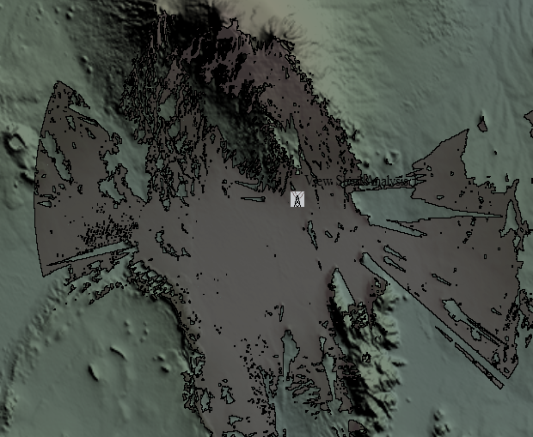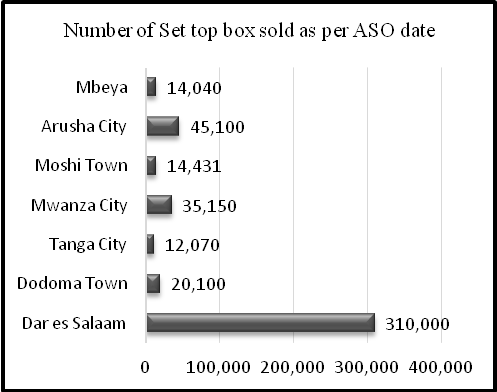-
Paper Information
- Paper Submission
-
Journal Information
- About This Journal
- Editorial Board
- Current Issue
- Archive
- Author Guidelines
- Contact Us
International Journal of Networks and Communications
p-ISSN: 2168-4936 e-ISSN: 2168-4944
2015; 5(1): 18-22
doi:10.5923/j.ijnc.20150501.03
Exploring the Potential of DVB-T Networks for Broadband Connectivity in Tanzania
Sadath Kalolo , Christopher J. Assenga , Joseph S. Kilongola
Tanzania Communications Regulatory Authority, Dar es Salaam, Tanzania
Correspondence to: Sadath Kalolo , Tanzania Communications Regulatory Authority, Dar es Salaam, Tanzania.
| Email: |  |
Copyright © 2015 Scientific & Academic Publishing. All Rights Reserved.
Broadband connectivity is now an essential need in the day to day activities. For the past couple of years the introduction of mobile telephone services and broadband connectivity have changed the way people talk, purchase, plan and connect to others. It has further been a catalyst for economic and social development by bringing new ways for businesses to reach out to new customers. Value added services over mobile telephone and internet like mobile money transfer, mobile banking, online air ticket and social networking have added a new dimension to the way people approach to their daily activities. Though these changes are revolutionary, only a small segment of the population in Tanzania (those living in urban and sub-urban areas) could reap the benefits as broadband penetration in large part of the country is limited only in urban areas that have high population density. In this work we explore the potential of Digital Video Broadcasting–Terrestrial (DVB-T) networks for broadband connectivity in Tanzania. We propose the use of DVB-T networks as a downlink channel for broadband services and use the available GPRS/EDGE/HSPA/LTE networks as a return channel to enable interactivity. We further formulate the architecture of the network based on the available DVB-T networks’ coverage in the country following the analogue to digital migration. The performance evaluation of the proposed network architecture is left as a directions for further research works.
Keywords: DVB-T Networks, Broadband Connectivity, Downlink Channel, Return Channel and Network Interactivity
Cite this paper: Sadath Kalolo , Christopher J. Assenga , Joseph S. Kilongola , Exploring the Potential of DVB-T Networks for Broadband Connectivity in Tanzania, International Journal of Networks and Communications, Vol. 5 No. 1, 2015, pp. 18-22. doi: 10.5923/j.ijnc.20150501.03.
Article Outline
1. Introduction
- Broadband connectivity is now an essential need in the day to day activities of everyone in our communities. It is now increasingly recognized as a service of general economic interest [1]. Over the last decade, the growth of telecommunications industry has been remarkable where the global mobile cellular subscription reached 6.8 billion users in 2013 with global penetration rate of 96%. 128% penetration rate in developed world and 89% in developing countries [2]. In Tanzania, mobile cellular subscriptions reached 28.8 million in June 2014 with a penetration rate of 64% [3]. While this growth is remarkable, most of the subscriptions are on voice services especially in the developing world. Over 2.7 billion people are using internet as of 2013. In the developed world 77% of the population are online while only 31% of the developing world population is online [2]. This is caused by the high subscriptions costs of internet services offered by the traditional networks offering voice services. In Tanzania, user subscription into internet services is even low [4] and most of users are limited to urban and suburban areas. Despite the efforts made by the government to launch the program for backhaul connectivity by setting up the national optical fibre network to connect all regions and districts, end users have not been able to reap its benefits due to absence of affordable last mile connectivity. Last mile connectivity established by using either optical fibres (FTTH), copper cables (DSL) or wireless technologies has high capital expenditure and operational expenses [5]. Furthermore, though mobile penetration is high, the broadband services provided using mobile network (EDGE, UMTS, HSPA and LTE) are still too costly to be afforded by the majority of the users and the coverage of the broadband services is limited in urban and suburban areas [5], [6]. Other broadband connectivity networks available in Tanzania includes WiMAX and FTTH. However, WiMAX is also limited by the requirement of commercial spectrum which is expensive while FTTH is limited by the high investment costs and proneness to vandalism.As the population density is low in most of the suburban and rural areas, the return on investment (ROI) for broadband service provider is even lower. This calls for the necessity to find technologies which are affordable, provides wide coverage and high data throughput to serve large areas while offering viable business model for telecommunications service providers. In this work we explore the potential of digital video broadcasting terrestrial (DVB-T) networks for broadband connectivity in Tanzania following analogue to digital migrations. In section II, we present the related works on broadband connectivity and digital video broadcasting thereby proposing a hybrid network with a DVB-T network as downlink channel to enhance throughput and available mobile cellular networks (EDGE, UMTS, HSPA and LTE) as a return channel (Uplink channel). Section III presents the network architecture of the proposed network. In section IV, we analyse the current penetration and coverage of the DVB-T networks in Tanzania. Thus, exploring the potential of the networks for broadband connectivity. Section V concludes our work paving ways for the directions of further researches.
2. Related Works
- DVB-T is the world’s most advanced digital terrestrial television (DTT) system, offering more robustness, flexibility and at least 50% more efficiency than any other DTT system [7]. Furthermore, it is the most widely adopted and deployed DTT standard. Currently, over 70 countries have deployed DVB-T services [7]. The well established success is backed by the massive economies of scale and very low receiver prices. Following the analogue switched over in Europe and other places worldwide, DVB-T drew up commercial requirements for a more spectrum efficient utilizations and enhanced throughput. DVB-T2, a second generation of DVB-T easily fulfils these requirements which include; increased capacity, robustness and the ability to reuse existing reception antennas [8]. Like its predecessor, DVB-T2 uses orthogonal frequency division multiplex (OFDM) modulation with a large number of subcarriers delivering a robust signal with a range of different modes which makes it a very flexible standard. Low Density Parity Check (LDPC) combined with Bose-Chaudhuri-Hocquengham (BCH) coding are used to offer a very robust signal [8]. The number of carriers, guard interval sizes and pilot signals can be adjusted to allow optimization of overheads for any target transmission channel.The widespread adoption of the DVB-T technology makes it as a leading carrier for digital broadcast services. The capability of insertion of IP data services within the transmitted MPEG-4 stream multiplexed with digital television programs adds another viewpoint of using DVB-T networks as a broadband downlink channel offering high-speed data access to both stationary and mobile end users [9]. Likewise, the recent emergence of the digital video broadcasting for handheld (DVB-H) as an extension / improvement to DVB-T, adapt the digital broadcasting technology more to the needs of IP datagram transmission [10]. The adoption of additional Forward Error Correction layer and a time-slicing mechanism for energy saving, makes DVB-H a promising solution for broadband data access for handheld terminals. While technologies such as DVB-T and DVB-T2 are capable of providing high-speed information delivery over a large coverage area, yet they only work on a unidirectional transmission mode like any other broadcasting platform. Hence, the integration of traditional TCP/IP services within the digital broadcasting multiplex requires an additional interaction channel to act as an uplink (return channel) for conveying traffic from the user back to the service provider [9], [10]. The return channel may comprise any traditional network such as WLAN, GPRS, EDGE, UMTS, HSPA or LTE. Though, these networks have shown a limit on the provision of high data rates due to coverage limitations and high termination costs, they are capable of achieving the requirement of the return channel as only low data rates are required in the uplink. A heterogeneous network is thus formed, whose generic topology has been specified by ETSI [11].In the heterogeneous network, the DVB-T network is used for downlink data transmission, while the traditional communication network works as the return channel. The return channel provides bidirectional communications for signaling messages exchange and reliable data transmission via automatic repeat request [9]. The resulting network has high performance when applied to asymmetric services, which needs higher data rates in the downlink than in the return link. Furthermore, the network becomes suitable for information dissemination to a large number of subscribers based on the advantage of broadcasting.
3. Network Architecture
- We adopt the architecture specified by ETSI [11] and used in [9]. The architecture considered in this work is based on a unidirectional DVB-T broadcast network coupled with WLAN/GPRS/EDGE/UMTS/HSPA/LTE network. The efforts is to realize low cost services that may be brought by non-real time flows while efficiently using the residual DVB-T bandwidth. Figure 1 presents a simple network architecture in which the WLAN, GPRS, EDGE, UMTS, HSPA or LTE path is completely separated from the DVB-T path. A more realistic coupling architecture takes into account that return channel and DVB-T paths may be linked through some entities to provide a continuous service flow. Therefore, a new entity is needed to switch IP data from traditional services to DVB-T, and insert the data into the DVB-T residual bandwidth.
 | Figure 1. Generic System Reference Model for interactive Systems [11] |
4. Market Penetration Rate and Network Analysis
- Following the first phase of analogue to digital migration in Tanzania, the DVB-T, DVB-T2 and DVB-H networks have gained a considerable coverage areas. Signal coverage measurements were done for transmitters in Arusha, Moshi and Tanga service area. Three companies have been licensed to provide DVB-T service and deployed their networks to cover the whole country. The companies include; Star Media (T) Limited, Basic Transmissions (T) Limited and Agape Associates (T) Limited. The DVB-T spectrum is also licensed to the three companies to enable signal distributions throughout the country. Currently all networks are offering broadcasting services only.The footprint of the transmitters reveals a good coverage in urban, suburban and few parts of rural areas. The wide coverage coupled with higher throughput in the downlink reveals the potential of the DVB-T networks for broadband connectivity in the country. Figure 2 and 3 below present the findings of the coverage of DVB-T networks in Arusha and Moshi service areas.
 | Figure 2. DVB-T Coverage in Arusha Service area |
 | Figure 3. DVB-T Coverage in Moshi Service area |
 | Figure 4. Set top boxes sold after ASO Phase I date [12] |
|
5. Conclusions
- Broadband connectivity is a substantial tool for the day to day activities of our communities. Traditional networks are offering broadband connectivity to only few users due to the fact that they are expensive and their coverage are limited urban and suburban areas. The DVB-T networks presented in this work provides the potential for broadband connection in Tanzania. The capability of delivering high capacity data in one direction only and the presence of low capacity GPRS/EDGE/UMTS/HSPA/LTE to serve as a return channel ensures the interactivity to end users. Our measurements indicates the availability of wide signal coverage in switched over areas. The available DVB-T signal coverage coupled with the set top boxes distributed in the switched over areas, provides a potential resources for broadband connectivity in underserved areas. Performance evaluations of the proposed network architecture is earmarked as our direction for future works.
 Abstract
Abstract Reference
Reference Full-Text PDF
Full-Text PDF Full-text HTML
Full-text HTML